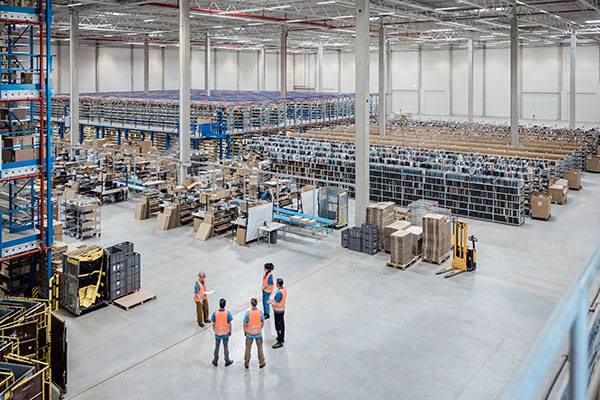The industrial real estate market looks a lot different than it did just a few years ago. Demand is shifting, vacancy rates are up, and companies are rethinking their space needs. Stephanie Rodriguez, National Director of Industrial Services at Colliers, shares how she’s helping clients make smart decisions in what she calls a “VUCA” era—short for volatility, uncertainty, complexity, and ambiguity.
What’s Related
Supply Chain 24/7: How would you describe the current state of the industrial real estate market in 2025?
Stephanie Rodriguez: The U.S. industrial market is bifurcated at the moment. Record new supply in response to unprecedented industrial demand during and following the pandemic has pushed vacancy up over the last 11 quarters from a low of 3.5% in mid-2022 to 7.1% at the end of the first quarter. While this is a healthy level, historically speaking, it’s also the highest rate since 2015. Some markets built more space than others, especially relative to their size, and vacancy climbed even higher, in some cases well into the double digits. New supply and tenant demand are still out of balance in these markets, while in others, the equilibrium between the two metrics has returned, and vacancy is below the national average and on its way down again. Nationally, vacancy is rising more slowly and is expected to peak by the end of the year as the gap between new supply and demand narrows.
SC247: What lasting effects from the COVID-era e-commerce boom are still shaping demand for industrial space?
SR: The big push for new industrial development in response to unprecedented levels of demand from distributors, third-party logistics providers, retailers, and e-commerce users is winding down. It peaked at 711M SF under construction at the end of 2022 and dropped below pre-pandemic levels to 279M SF by the end of the first quarter. The construction pipeline is projected to shrink further to around 250M SF by the end of 2025, as many developers put their projects on hold, delaying the next wave of speculative construction until vacancy rates begin to fall again and economic clarity emerges.

Stephanie Rodriguez
SC247: Are companies still scrambling for warehouse space, or has that demand started to level out?
SR: Industrial demand has slowed to below pre-pandemic levels, but is still positive, indicating new occupancies are outpacing new vacancies. In fact, net absorption has now been positive in the U.S. industrial market for more than 14 years in a row. Companies are taking a more strategic approach to real estate decision-making in response to shifting market conditions.
SC247: How are companies balancing the need for space with higher borrowing and construction costs?
SR: Industrial rents have grown 74% since 2020, and much more quickly than that in many markets. Warehouse and distribution rent growth peaked at 25% year-over-year in mid-2023 but has tapered since. It’s still positive, however, growing at 6% year-over-year during the first quarter. While some companies may be hesitant to pay higher rents than they are used to, rent remains one of the smaller components of operational costs to most companies. Companies with strong balance sheets and accessible capital are still making investments on an as-needed basis. However, the first line of defense remains portfolio and space optimization, where efficiency is critically evaluated and adjusted for with minimal capital required. It makes sense to make adjustments to their operations versus moving to new real estate, in some cases. This has become more prevalent in the past 24 months and will likely continue in the short term.
SC247: What role is re-shoring playing in industrial real estate decisions right now?
SR: Manufacturing construction spending is up, with many large-scale advanced manufacturing projects underway throughout the country in response to the 2022 CHIPS Act. These are primarily semiconductor and EV/battery facilities being built in the South, Midwest, and West regions. As a result, reshoring and FDI (foreign direct investment) job announcements have been up in recent years as well. While more manufacturers may consider re-shoring in their real estate decisions, labor availability, construction costs, and the lengthy timelines required to build new facilities remain key factors in the evaluation process.
SC247: Are you seeing an increase in interest in new manufacturing or distribution facilities in certain areas?
SR: The biggest investment in advanced manufacturing projects is in the South region, followed by the West region (where the largest projects are located, primarily in Arizona), then the Midwest region.
SC247: How do you help clients make decisions when the environment is this unpredictable?
SR: Our goal is to provide data-driven solutions to our clients. We utilize technology and our local market knowledge to provide thoughtful insights and focus on understanding the customer’s long-term strategy when advising them.
SC247: Is there a particular trend or shift that you think most people are underestimating in industrial real estate today?
SR: Asian-based 3PLs have been dominating leasing trends over the past year and a half. In 2024, they represented 27% of all 3PL, trucking, and transportation bulk industrial occupancies, a notable trend and a significant increase year-over-year. In some markets like Philadelphia, Savannah, and Greater LA, Asian 3PLs represented more than 40% of the new occupancies in this category. While this trend is expected to carry into 2025, uncertainty may slow new leasing from Asian-based 3PLs in the near term.

